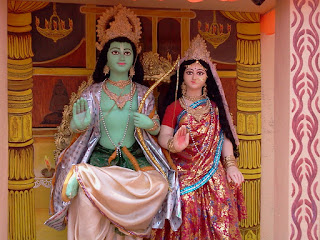Reading Notes: Gould's Divine Archer B
Figure 1: Sita and Rama Wikimedia
Seeing as the plot is virtually identical to the previous version of the Ramayana, I'll focus on something else this time. I enjoyed the similes and metaphors that Gould used. They actually remind me of how folk stories are passed down, and the stories that my father told me when I was younger. It really gives the feeling that this is a story naturally spread among people. I also find it strange how Gould modified the story significantly. For starters, he provides far fewer details about the final conflict in Lanka. He also tries to reconcile the character inconsistency when Rama exiles Sita, making Rama clearly anguished at having caved to political pressure and having that weigh on him constantly.
I think it would be fun to reconcile Rama's character to make him more consistent (and honestly better written) sounds fun. I'm not saying the Ramayana is bad, but it appears to be an amalgamation of some other stories, which leads to inconsistency. I also find it strange that Gould did not depict Rama's departure to the godly realm, only Sita's. Perhaps rewriting Rama's departure in Gould's style sounds productive.
I think it would be fun to reconcile Rama's character to make him more consistent (and honestly better written) sounds fun. I'm not saying the Ramayana is bad, but it appears to be an amalgamation of some other stories, which leads to inconsistency. I also find it strange that Gould did not depict Rama's departure to the godly realm, only Sita's. Perhaps rewriting Rama's departure in Gould's style sounds productive.
The Divine Archer by Gould



Comments
Post a Comment